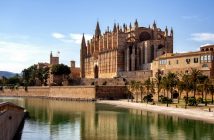Enduring, apocryphal, shrouded in myth and legend – as are the places she visits – Margaret May takes a turn in the endearing mystery that is Glastonbury…
History and a romanticised conception of the town and its dominant medieval tower combine to make Glastonbury and its environs one of the major areas in the West Country to which tourists gravitate. And not just tourists; Glastonbury has something of a reputation for being a New Age town where Christians, Druids, atheists and agnostics seem to sit comfortably together revelling in both the great outdoors and their spiritual and/or scientific beliefs.
Early stories – and it is not for me to determine whether they be myth, legend or fact – centred on the belief that Jesus once visited here with his great-uncle, Joseph of Arimathea. Apparently Joseph had brought with him the chalice from the Last Supper, the Holy Grail, with the intention of burying it beneath a spring near the Tor. Later people were swayed with the thoughts that King Arthur and Queen Guinevere were buried here, and that the site was the original Avalon. Others were confident in the knowledge that the Tor was, in fact, some sort of protectorate of the entrance to Hades and the mysteries of the underworld. Whatever captures one’s beliefs and imagination it is easy to see how such cerebral, empirical or impassioned fires are fuelled.
The first time I climbed the Tor – a Celtic word to depict a hilly mound shaped as if a triangular wedge of cheese (very apt for Somerset and its cheese-making history) – I was accompanying some thirty 7-year old schoolchildren on a day trip. The headmistress strode dutifully up on this steep and rocky incline 160 metres to the top where we encountered much giggling from the children. A naked man lay blissfully under the ruins of the tower obviously enjoying this tryst with nature and quite uncaring about his audience. He had no clothes with him, just a handful of daisies. He gazed to the skies, chanted and sang. The headmistress jabbed her umbrella at him and told him to be off. Very good-naturedly, I thought, as he could have had some damage done there, he blew kisses to the children and skipped off down the hill singing, and prancing like a spring lamb, and tossing his daisies into the breeze.
Such a place is Glastonbury – I wonder what Bill Bryson would have made of it? At the top of the Tor, a tower, all that remains of the medieval St. Michael’s Church, contains a carving of the saint weighing the souls of the dead. This sets my imagination ablaze – how much should they weigh? What’s the limit? Might there be some penalty for excess weight?
Before descending the hill I savour the 360 degree view, much of it over Somerset. It’s a glorious day and this beautiful county is stretched out before me – it does instill a sense of spiritualism if not just a sheer appreciation of our English history to be in such magnificent surroundings. The views bring to my mind the long-explored theories of early fertility rituals where it has been suggested that the Tor, Stonehenge, and the famed Avebury Rings in Wiltshire were all built to a particular triangular perspective. Mathematical calculations had engendered the belief that allowing the sun to align with each landmark at sunrise would enhance fertility, and most particularly on midsummer’s day. Of course we’ll never know for sure, but it’s fascinating to think about and so enriching of our historical knowledge.
In the town itself I find that the local shops are full of herbal remedies, candles, incense sticks, crystals, symbolic jewellery and wall hangings, religious and pagan prints, paintings and sculptures. The bookshops cover every subject from orthodox religions to alternative lifestyles, herbal cooking, the nudist way of life, books of runes and kells, tarot cards, witchcraft and wizardry, Arthurian legends and medieval architecture. I could dwell there for hours, happy in my perusing, but I’m keen to visit the wonderful ruined remains of Glastonbury Abbey. A very atmospheric structure built originally as a monastery. Given the political and religious upheavals of the times the Abbey fell into disrepair after Henry VIII dissolved all monasteries in his fight against the papacy. The last Abbott here suffered the ignominious fate of being hung, drawn and quartered on the Tor, and the Abbey itself was plundered to provide building materials for scavengers. There’s real history as equally as alluring as the myths that surround this place.
It would be impossible to leave Glastonbury without envisioning the scenes, over three days in June, when Woodstock appears to have been transported to our own green fields for an extravaganza of music played out under these starry skies. People of all ages, and from all walks of life, converge here to tune in, out, turn on or off, jump up or drop out and abandon themselves to the potent and heady combination that a mix of ancient history, New Ageism, music – and perhaps certain substances – has generated.
Glastonbury is a fascinating place – a compelling and inspiring coalescence of history, tradition and legend. A part of the backbone of English history, if one is open to it, this is a place to savour, appreciate and, to remember. It is, after all, our past, our present and a wonderful inheritance for those in the future.
Glastonbury 2015 takes place from the 24th-28th June. It is sold out but details on the line-up and further information can be found at www.glastonburyfestivals.co.uk.
There is, of course, more to Glastonbury than the festival. For a guide to the town and surrounding area, visit www.glastonbury.co.uk.




